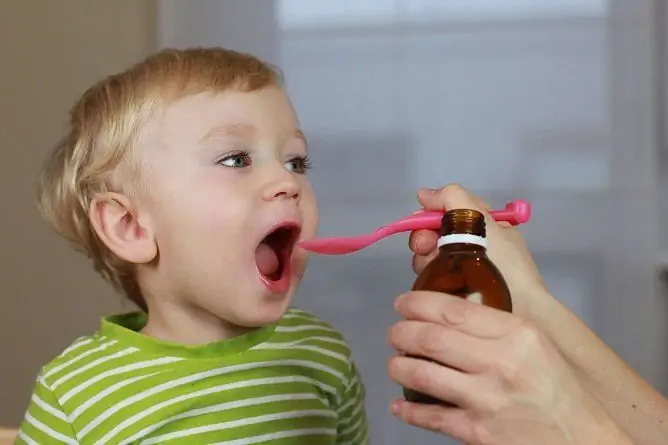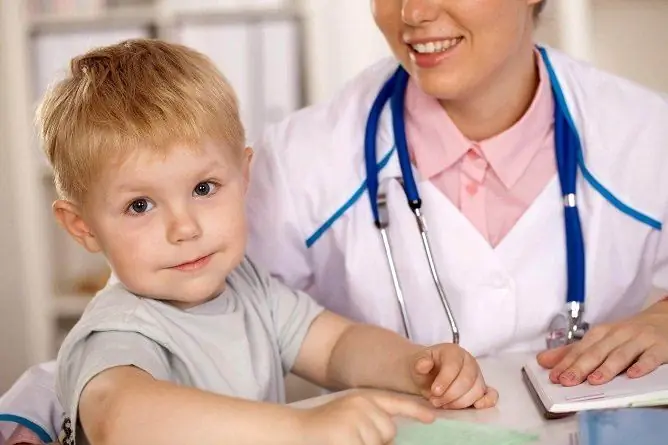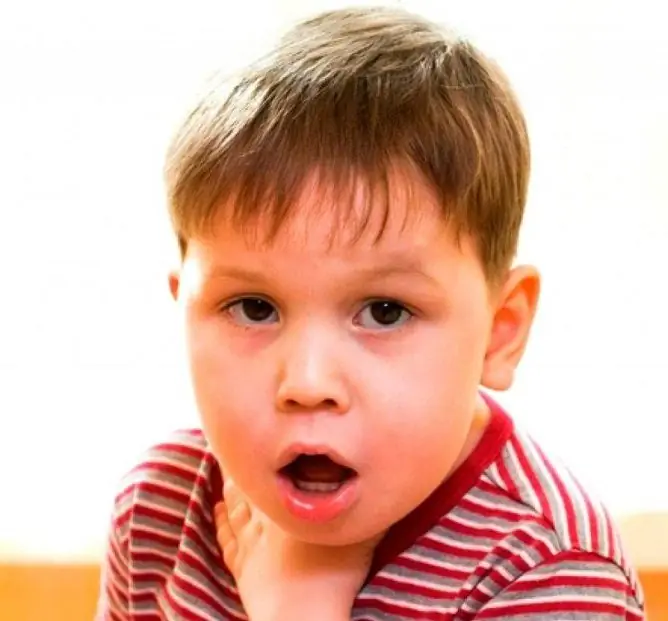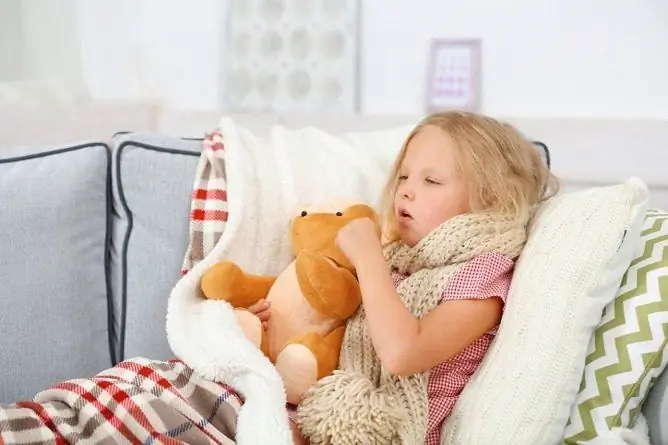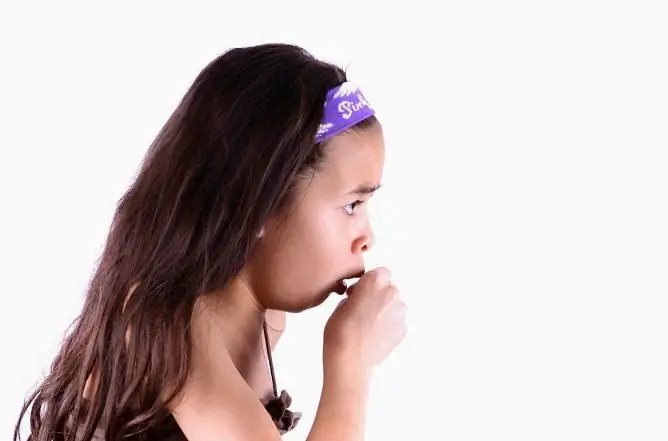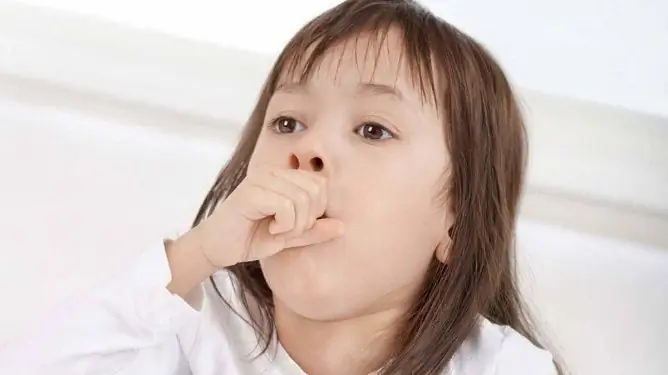- Author Rachel Wainwright [email protected].
- Public 2024-01-15 19:51.
- Last modified 2025-11-02 20:14.
How to treat a cough in a 3-year-old child at home: proven remedies
The content of the article:
-
How to treat a cough in a child 3 years old
- Treatment of cough in a child 3 years old at home
- How to create conditions for recovery
- Inhalation
- Folk recipes
- Drug treatment
- Treatment of the primary disease
- How to suspect the cause of the disease
- Treatment depending on the cause
- Video
How to treat a cough in a child 3 years old
How to treat a cough in a 3-year-old child depends on several factors: the cause, the presence of sputum and the degree of impairment of well-being. Cough in babies can occur 4-5 times a year or more, which often worries parents. But cough is not a separate disease, and it is not always wise to get rid of it, as it helps to clear the airways.
Treatment of cough in a child 3 years old at home
In most cases, coughs in children can be treated at home after consulting a doctor. To do this, use a therapeutic and protective regime, abundant drinking, inhalations, medicinal plants and medications.
Parents need to remember that some diseases require hospital treatment. For example, with stenosing laryngotracheitis, pneumonia, airway obstruction by a foreign body.
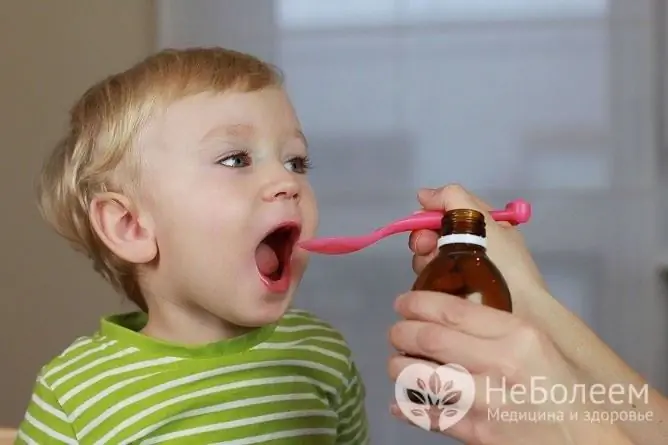
Not all antitussive drugs are suitable for young children; only a doctor should prescribe treatment
How to create conditions for recovery
The main task of parents is to create the necessary conditions for the child's recovery. How can you alleviate the child's condition and speed up recovery:
- Humidify the air. Insufficient humidity in the air leads to dryness of the mucous membranes, which increases the cough. You can use special humidifiers or arrange containers with liquid in the child's room.
- Ventilate the room to provide the child with fresh air.
- Daily wet cleaning in his room.
- Provide plenty of fluids. It is necessary to give the child warm teas, mineral water without gas, milk with honey, decoctions of medicinal herbs. Drinking plenty of fluids soothes coughs, relieves symptoms of intoxication, and speeds up recovery.
- Eliminate hypothermia, limit contact with cold air. The child should not freeze, but it is important not to overdo it, so as not to lead to overheating. The optimum ambient temperature is 18-20 ° С.
Inhalation
Inhalations can be used to treat a 3-year-old child. The safest and at the same time effective for the baby are inhalation with a nebulizer.
In the presence of other symptoms, inhalation with medications is carried out. For example, with bronchodilators for bronchospasm, with antibiotics for bacterial infection.
Warm inhalations with essential oils have worked well for upper respiratory tract inflammation. For cooking, use warm water (no more than 55 ° C) and eucalyptus or pine oil. The action of such inhalations is based on the creation of a protective layer for the pharyngeal mucosa.
How to properly inhale:
- the child should breathe through the mouth, not through the nose;
- the frequency of the procedure is 2-3 times a day;
- duration of inhalation is 2-5 minutes;
- the duration of treatment is 7-14 days.
It is not recommended to use steam inhalation to treat a 3-year-old child, as it is dangerous.
Folk recipes
When treating young children, parents often try to do without medication, using only folk remedies. In some cases, this may indeed be sufficient. For example, if a child has a cold or residual symptoms after a respiratory infection. In other cases, you should not rely only on folk remedies. Traditional medicine can be used as an additional, but not the main method of treatment.
The following medicinal plants are used to treat children:
- Expectorants. Thinning phlegm and making it easier to remove. This effect is possessed by marshmallow, anise, oregano, plantain, thermopsis.
- Enveloping. Create a protective layer on the mucous membrane of the upper respiratory tract. Eucalyptus, licorice, acacia, wild cherry have an enveloping effect.
- Anti-inflammatory. Reduces inflammation of chamomile and calendula.
Decoctions and infusions are prepared from medicinal plants, and are also used to prepare a solution for inhalation.
In addition, you can use old recipes: compress on the chest, milk with honey, woolen socks.
Folk recipes do not cure the disease, but can alleviate the condition of the child. Such methods should not replace other therapy, if needed.
Drug treatment
Not in all cases of illness, the child needs to take medication. Symptomatic drug treatment is selected by the doctor taking into account the presence or absence of sputum, the degree of impaired well-being.
| A type of cough | Group of medications | |
| Wet | With viscous mucus that is difficult to cough up | Mucolytics and secretomotor |
| With liquid sputum | Not applicable | |
| Dry | Without disturbing well-being | Not applicable |
| Agonizing, disturbing sleep | Antitussives: central and peripheral | |
In children under 3 years of age, sputum is most often difficult to cough up. This is due to the insufficient activity of the ciliated epithelium, which promotes the excretion of mucus, as well as the fact that the bronchial glands produce a viscous secretion. Therefore, babies can be prescribed expectorant drugs:
- Alteika syrup;
- Acetylcysteine;
- Ambroxol;
- Bromhexidine.
Such drugs increase the activity of the ciliated epithelium or thin phlegm. Thanks to this, it is easier to remove and does not stagnate in the respiratory tract.
Antitussive drugs are used only for dry, painful cough, which is accompanied by vomiting or feeling unwell. In this case, antitussive drugs of peripheral action are prescribed. They decrease the sensitivity of the cough receptors located in the lower respiratory tract. These drugs include Libexin. Central antitussive drugs for a child under 3 years old are prescribed in exceptional cases, since they can lead to depression of the respiratory center.
Treatment of the primary disease
To cure a child, you need to fight not with the symptom, but with its cause. The reasons can be very different, ranging from ARVI and ending with bronchial asthma. If the underlying disease is cured, the child's cough will go away on its own.
How to suspect the cause of the disease
To identify the cause of the cough, you need to see a doctor. The doctor will examine the child, prescribe the necessary examinations and make a diagnosis.
At home, one can only suspect a disease. For each disease, there are characteristic symptoms, the nature of the cough is also different.
| Disease | The nature of the cough | Additional symptoms |
| SARS, colds | At the onset of the disease - dry, after 2 weeks - wet | Increased body temperature, general weakness, lethargy |
| Residual effects after infection | Rare, in the form of a cough | Absent |
| Stenosing laryngotracheitis | Barking, obsessive. Occurs paroxysmal, more often at night | Signs of respiratory distress (shortness of breath, pale or blue skin, rapid breathing) and hoarseness |
| Bronchial asthma | Dry, after an attack, vitreous sputum leaves | During the attack, there is expiratory dyspnea (difficulty exhaling) |
| ENT pathology (tonsillitis, adenoiditis) | Dry, aggravated at night | Nasal congestion, sore throat, fever |

To improve sputum discharge, it is recommended to drink more
Treatment depending on the cause
The main direction of treatment in most cases is getting rid of the cause of the disease.
With ARVI, etiotropic treatment (influence on the cause) is not applied. It is enough to give the child a lot to drink, carry out inhalation and symptomatic treatment. At high temperatures, antipyretic drugs are used - Ibuprofen, Paracetamol. If the cough is caused by the influenza virus, then antiviral therapy is prescribed - Oseltamivir.
Residual cough also does not require specific treatment. If the child does not have other symptoms, and the state of health is not disturbed, it is enough to follow the general recommendations.
With bronchial asthma, the main thing that needs to be done is to eliminate contact with the allergen. If this is not possible, the child is prescribed medications (antihistamines, glucocorticoids). During the period of remission, when all symptoms have disappeared, desensitization should be performed.
With ENT pathology, treatment is aimed at sanitizing the focus of infection. What is used to treat a child:
- Nasal lavage - cuckoo method, nasal spray with seawater or saline.
- Gargling. To do this, use water with soda or salt, chamomile decoction, "Chlorophyllipt".
- Antibacterial drugs. They are used for severe inflammation caused by bacteria. Amoxicillin, Azithromycin, Amoxiclav are used to treat a 3-year-old child.
Stenosing laryngotracheitis is treated at home in the initial stage, but only after consulting a doctor. For treatment, distracting procedures (foot baths, inhalations) and medications are used. The use of decongestants is shown - antihistamines and glucocorticoids.
Video
We offer for viewing a video on the topic of the article.
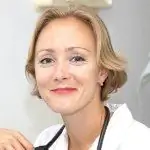
Anna Kozlova Medical journalist About the author
Education: Rostov State Medical University, specialty "General Medicine".
Found a mistake in the text? Select it and press Ctrl + Enter.

